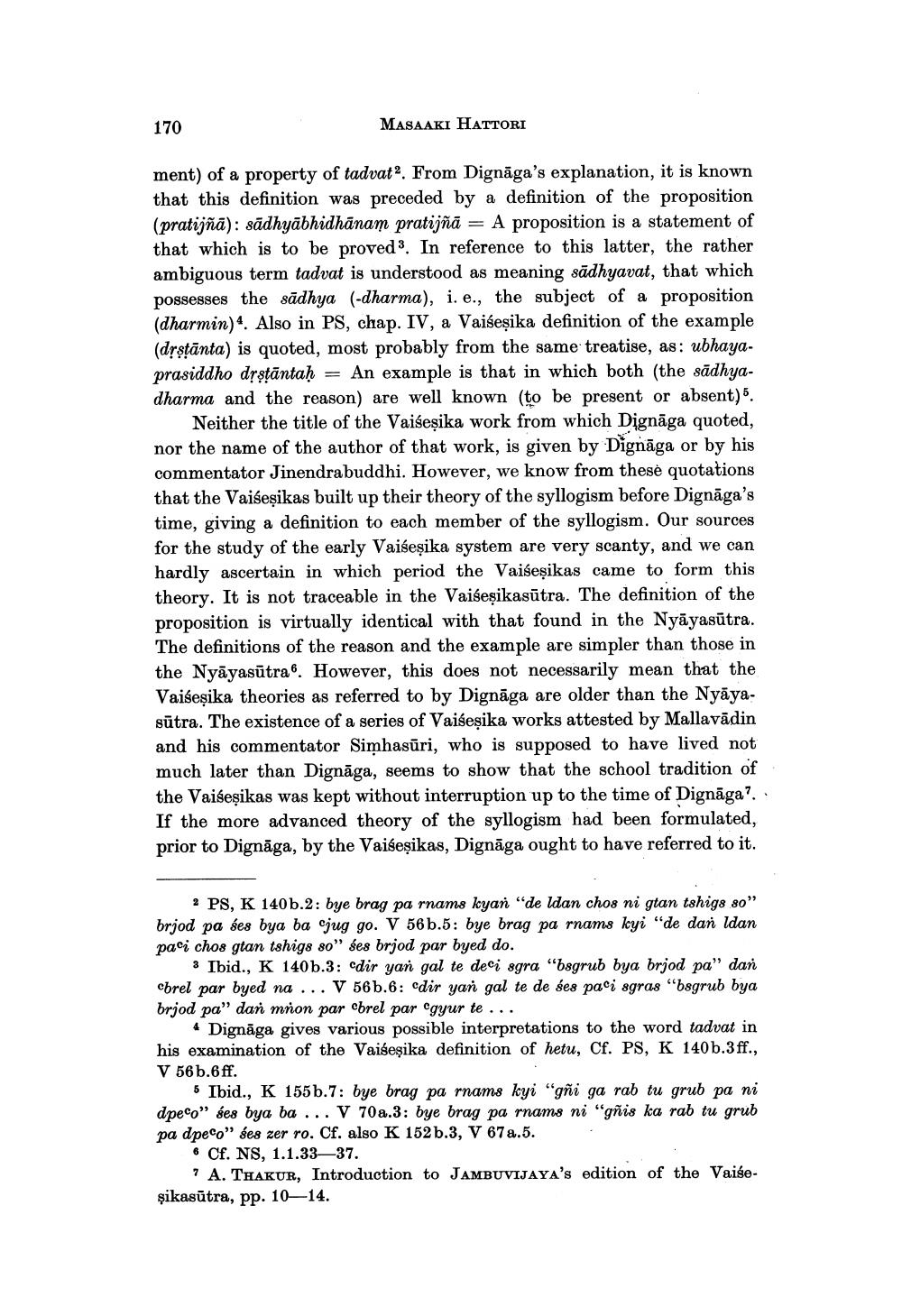Book Title: Note On Development Of Vaisesika Theory Of Anumana Author(s): Masaaki Hattori Publisher: Masaaki Hattori View full book textPage 2
________________ 170 MASAAKI HATTORI ment) of a property of tadvat2. From Dignaga's explanation, it is known that this definition was preceded by a definition of the proposition (pratijñā): sadhyābhidhānam pratijñā A proposition is a statement of that which is to be proved3. In reference to this latter, the rather ambiguous term tadvat is understood as meaning sadhyavat, that which possesses the sadhya (-dharma), i. e., the subject of a proposition (dharmin). Also in PS, chap. IV, a Vaiseṣika definition of the example (dṛṣṭanta) is quoted, most probably from the same treatise, as: ubhayaprasiddho dṛṣṭantaḥ An example is that in which both (the sadhyadharma and the reason) are well known (to be present or absent) 5. Neither the title of the Vaiseṣika work from which Dignaga quoted, nor the name of the author of that work, is given by Dignaga or by his commentator Jinendrabuddhi. However, we know from these quotations that the Vaiseṣikas built up their theory of the syllogism before Dignaga's time, giving a definition to each member of the syllogism. Our sources for the study of the early Vaiseṣika system are very scanty, and we can hardly ascertain in which period the Vaiseṣikas came to form this theory. It is not traceable in the Vaiseṣikasutra. The definition of the proposition is virtually identical with that found in the Nyāyasūtra. The definitions of the reason and the example are simpler than those in the Nyayasutra. However, this does not necessarily mean that the Vaiśeşika theories as referred to by Dignaga are older than the Nyayasutra. The existence of a series of Vaiseṣika works attested by Mallavadin and his commentator Simhasuri, who is supposed to have lived not much later than Dignaga, seems to show that the school tradition of the Vaiseṣikas was kept without interruption up to the time of Dignaga". If the more advanced theory of the syllogism had been formulated, prior to Dignaga, by the Vaiseṣikas, Dignaga ought to have referred to it. = 2 PS, K 140b.2: bye brag pa rnams kyan "de ldan chos ni gtan tshigs so" brjod pa ses bya ba cjug go. V 56b.5: bye brag pa rnams kyi "de dan ldan paci chos gtan tshigs so" ses brjod par byed do. 3 Ibid., K 140b.3: cdir yan gal te deci sgra "bsgrub bya brjod pa" dan cbrel par byed na... V 56b.6: cdir yan gal te de ses paci sgras "bsgrub bya brjod pa" dan mnon par cbrel par gyur te... 4 Dignaga gives various possible interpretations to the word tadvat in his examination of the Vaiśesika definition of hetu, Cf. PS, K 140b.3 ff., V 56b.6ff. 5 Ibid., K 155b.7: bye brag pa rnams kyi "gñi ga rab tu grub pa ni dpeco" ses bya ba... V 70a.3: bye brag pa rnams ni "gñis ka rab tu grub pa dpeco" ses zer ro. Cf. also K 152b.3, V 67a.5. Cf. NS, 1.1.33-37. 7 A. THAKUR, Introduction to JAMBUVIJAYA's edition of the Vaiseşikasūtra, pp. 10-14.Page Navigation
1 2 3 4 5 6 7 8 9 10 11 12
